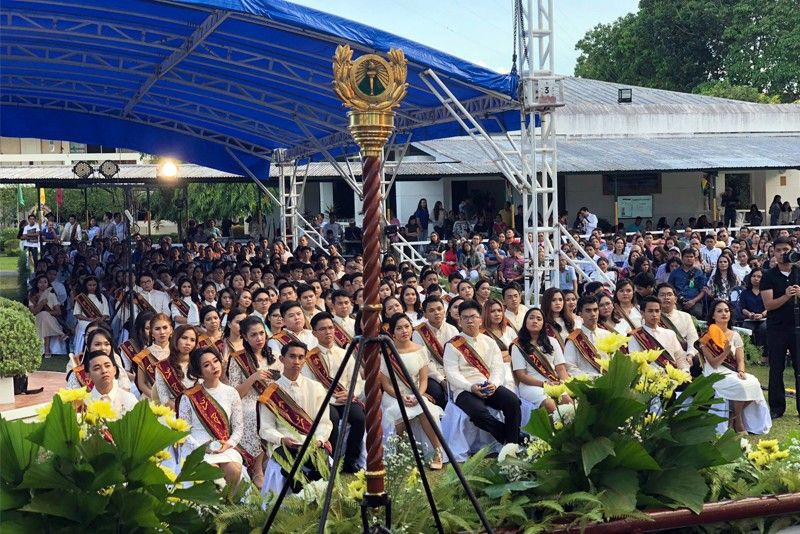Melodrama and more in this graduation

Late June is graduation season under the new academic calendar of the University of the Philippines, and since the UP System is made up of eight constituent universities spread out over 17 campuses, that’s a lot of graduations to attend for officials like me. Since the President can’t possibly be at all the ceremonies — which are sometimes scheduled on the same day, or just a day apart — we VPs decide early on where we want to go to represent the System administration.
Diliman is a given, being basically home. I also attend the rites of UP Manila, partly because I’m fascinated by the number and variety of degrees we hand out under the health sciences (culminating this year in the combined MD/PhD — a physician who’s also a researcher, the very top of the heap). But also, UP Manila — harking back to an earlier tradition — still requires its graduates to wear togas instead of the now-ubiquitous sablay or sash, which means I get to drag my US-university toga, or what I call my clown costume, out of the mothballs.
Last year I chose to go to UP Baguio, only to realize, the night before the ceremony, that not only was I on the roster of visitors, but was also the commencement speaker—a little detail that no one had remembered to tell me. A faster commencement speech was never written. (I’ll admit it — I was thrilled to get the job done.)
This June, I selected UP Tacloban — not yet a constituent university but a college under the supervision of UP Visayas. I picked Tacloban because I hadn’t been there for at least 15 years since the early 2000s, and I wanted to see how the campus and the city had recovered from Yolanda’s devastation. I imagined that It was still scarred by the catastrophe five years after; instead, as soon as we landed, I was impressed by how quickly the place had gotten back on its feet, abuzz with tricycles and new construction.
With a morning to spare, I walked about town with Beng (who had come along at her own expense to see old friends) and toured the still-sequestered Sto. Niño Shrine (always more a shrine to the Marcoses), badly ravaged by the storm and by neglect. An even sorrier sight was the adjacent People’s Center and Public Library, which had been converted to a Japanese surplus store. I don’t bemoan the humbling of excess, but as Beng reminded me, “This was the people’s money.”
One happy discovery I did not expect was Tacloban as a food paradise. Wherever we went and at whatever price point — the surf and turf combo and the grilled marlin at the hotel, the fish tinola, the grilled scallops, and bulalo at the Acacia restaurant, more tinola and nilagang carabeef at the unli-rice Pinutos at the mall, and the lemongrass roasted chicken at the now-iconic Ayo restaurant — the food was fresh and flavorful, the beef amazingly tender and the tinola divinely laced with lemongrass and ginger.
All that fortified us for the graduation, which was fairly small as UP graduations go, with just about 200 graduates, two of them finishing magna cum laude, from such fields as Accountancy, Management, Communication Arts, Biology, Computer Science, and Political Science. Tacloban Dean Dr. Dodong Sabalo, a management expert, introduced me to the commencement speaker, Debbie D. Namalata, San Miguel Brewery’s national sales manager and vice president for sales, and a UPV alumna, who gave a stirring talk about how her family overcame poverty to achieve professional success against all odds. It was a theme echoed by the valedictorian, Kim Decolongon Limosnero, whose mother had sold chicharon to put him and his siblings through school.
You’d think that I would get bored going to these graduations and witnessing the endless parade of young people coming up the stage in their Sunday best with their parents in tow, but I honestly never do, especially when I listen to such stories as Debbie’s and Kim’s, and see fathers wearing denims and sneakers not because they want to look hip but because it’s the best outfit they can afford. There wasn’t a dry eye in the house when Kim addressed his widowed mother — who had never finished college — as “my summa cum laude,” and I recalled my own parents who had similarly labored mightily to send all five of us to school.
And as I sat onstage, I received the saddest message on my phone, about another UP student named Jemima Faye Dangase, who was supposed to graduate cum laude in Agribusiness Economics from UP Mindanao. The daughter of very poor parents — her diabetic father was a municipal utility worker and her mother was unemployed — Jemima was clearly her family’s hope. She submitted all her requirements for graduation, went home, then crumbled in pain — pain she had borne quietly for months without complaint, apparently so as not to trouble her already beleaguered parents. She was brought to the hospital, where doctors discovered her organs ravished by cancer; and there she died.
I know it borders on melodrama, but this is, truly, the story of Philippine education and why it’s so crucial to social transformation. For every Jemima who stumbles on the very last steps, there must be a Kim who breaks through. This is why going to such places as Tacloban revives my faith in the Filipino future, despite the dark travails of the present, in this moral equivalent of a Yolanda, which — reposing our faith in a God wiser than all despots — we will survive.
* * *
Email me at jose@dalisay.ph. and visit my blog at www.penmanila.ph.



















